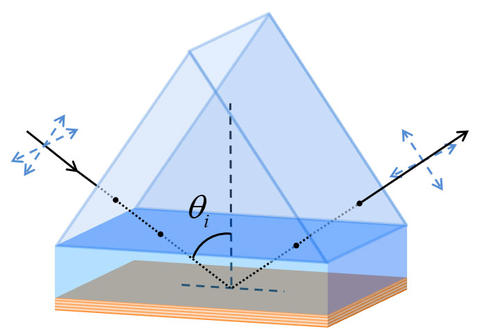Through a Prism Brightly: A New Way to Measure the Light-Warping Properties of Hyperbolic Metamaterials

Illustration of incident light traveling through a glass prism before entering and after exiting the hyperbolic metamaterial, which is composed of stacked metal and transparent oxide layers. By sending incident light through the glass prism, the researchers minimize the mismatch between the wavelengths of light in air and in the hyperbolic metamaterial. This enables the light to penetrate farther into the metamaterial and more accurately assess its electromagnetic properties.
Manipulating light in a variety of ways—shrinking its wavelength and allowing it to travel freely in one direction while stopping it cold in another--hyperbolic metamaterials have wide application in optical communications and as nanoparticle sensors. But some of the same optical properties that make these metamaterials so appealing make them frustratingly difficult to evaluate.
For example, the mismatch between the wavelength of incident light, traveling through air, and the much shorter wavelength inside these metamaterials typically prevents the incident light from penetrating very far. That property can be used to create a nanoparticle sensor but poses a problem for measuring just how well a hyperbolic metamaterial performs its light-warping feats, characterized by an electrical property known as permittivity. If light can’t probe deeply into a hyperbolic metamaterial, it can’t accurately assess the permittivity.

CNST researchers have now developed a new measurement method that circumvents this difficulty. Using an off-the-shelf glass prism to enhance the interaction of incident light with hyperbolic metamaterials, a team led by Cheng Zhang of the CNST and the University of Maryland’s NanoCenter and Henri Lezec of NIST has devised a simple and much more accurate way to determine the permittivity.
Zhang, Lezec and their colleagues, which include researchers from the J.A. Woollam Co. in Lincoln, Nebraska, and the University of Michigan in Ann Arbor, described their findings in a recent issue of ACS Photonics.
The glass prism serves two functions. Light traveling through glass has a wavelength intermediate in size between that of the incident light and the light inside a hyperbolic metamaterial. By sending light into the glass prism before it enters the hyperbolic metamaterial, the researchers minimize the mismatch in wavelength, enabling the light to penetrate farther into the material. In addition, the shape of the prism directs the light to strike the hyperbolic metamaterial at the optimum angle to probe the material
Because the technique uses an off-the-shelf prism and does not require any modification of the hyperbolic metamaterial, it promises to serve as a reliable and easy to adopt method to characterize a broad class of highly anisotropic materials—structures whose optical properties depend on the angle at which light strikes the surface. And as Zhang and his colleagues fabricate more complex versions of such materials, using nanoengineered layers of different compounds, such measurements will take on added importance.
Paper:
Cheng Zhang, Nina Hong, Chengang Ji, Wenqi Zhu, Xi Chen, Amit Agrawal,
Zhong Zhang, Tom E. Tiwald, Stefan Schoeche, James N. Hilfiker, L. Jay Guo, and Henri J. Lezec. Robust Extraction of Hyperbolic Metamaterial Permittivity Using Total Internal Reflection Ellipsometry. ACS Photonics, Publication Date (Web): March 13, 2018. DOI: 10.1021/acsphotonics.8b00086

